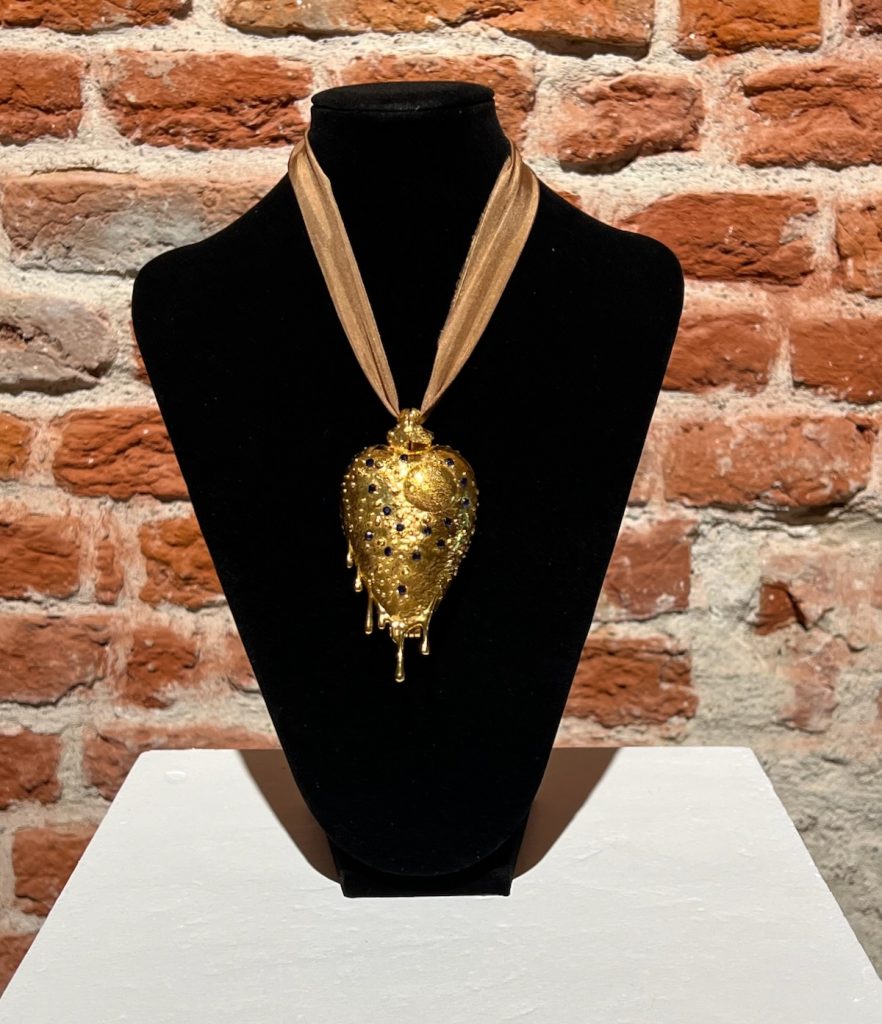
“Zenexton” (2022) is a contemporary amulet to ward off disease. In around 1570 Theophrastus Paracelsus coined the mysterious term Zenexton, to mean an amulet that would be worn around the neck and protect the wearer from the plague. Until that time amulets had a more general purpose of warding off (unspecified) disease, rather like the difference nowadays between ‘broad spectrum’ antibiotics versus antibiotics carefully targeted to a specific organism informed by genomics approaches. Paracelsus said he did not believe he would invent an effective Zenexton in his day, and that it was a task for future generations. In over the next one hundred or so years, something like a twisted version of the scientific method as we know it followed over what the Zenexton should contain, for example: a paste made of powdered toads, sapphires that would turn black when they leeched the pestilence from the body, amber if you couldn’t afford sapphires, menstrual blood and so on. Bizarre improvements were later made to the concoction, ‘of course’ they reasoned, ‘the toad should be finely powdered’, ‘the menstrual blood from a virgin’, ‘collected on a full moon’ and so on.
Unlike the concoctions of that era this contemporary Zenexton offers the wearer something that will genuinely protect them, as it contains a recently developed vaccine against Yersinia pestis (the bacterium that causes plague) developed by Professor Christine Rollier and colleagues at the University of Oxford using the ChAdOx1 platform (the same vaccine platform used to create the Oxford/Astra Zeneca COVID-19 vaccine).
This amulet is 3D printed in gold plated brass, and its design references the history of the Zenexton including contemporary laboratory made sapphires, the texture of toad skin, of blood and of a full moon.
In collaboration Professor Christine Rollier (University of Surrey) and with thanks to the Oxford Vaccine Group. The project was made possible by Anna Dumitriu Institute for Advanced Studies (IAS) fellowship at the University of Surrey, hosted by Professor Mark Chambers.
Exhibitions
Life Eternal – The Nobel Prize Museum at Liljevalchs, Stockholm, Sweden

Zenexton (alongside Hypersymbiotics: Post Pandemic Edition) by Anna Dumitriu was part of Life Eternal – The Nobel Prize Museum at Liljevalchs Konsthall in Stockholm, Sweden from 1st October 2022 until 29th January 2023. Anna Dumitriu gave an ‘in person’ artist’s talk, entitled “Obsessed with Bacteria” discussing the work on 24th November 2022.

BioArt Revolutiuon, Timisoara 2023 European Capital of Culture, Romania
Zenexton was part of BioArt Revolution/ Revoluția BioArt, an innovative solo exhibition by Anna Dumitriu which brought together contemporary artistic approaches and modern scientific experiments to address issues of global relevance such as infection, climate change, and diversity took place as part of Timișoara 2023 European Capital of Culture, from 30th September to 1st October 2023. The exhibition, which was created in collaboration with the Romanian Science Festival, took place in the stunning setting of Bastionul Maria Theresia, Galeria 2, Str. Hector, nr. 1, Timișoara, Romania.
BioArt Knowledge, Yarrow Gallery, Oundle, UK

Zenexton was part of BioArt Knowledge: A Solo Exhibition by Anna Dumitriu at the Yarrow Gallery in Oundle, Near Peterborough, UK, from 9th November to 6th December 2023.
Fragile Microbiomes, Thackray Museum of Medicine, Leeds, UK

Zenexton is part of Fragile Microbiomes (solo exhibition) at the Thackray Museum of Medicine, Leeds, UK, from 10th February to 23rd June 2024.
